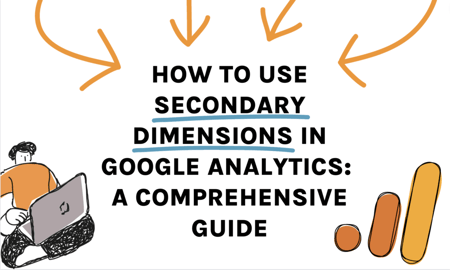SEO Proficiency: Deep Dive into Secondary Dimensions for Specific Metrics
Enhance Your Information Analysis Utilizing Additional Measurements
The real deepness of insights lies in the integration of secondary dimensions. The strategic use of additional dimensions raises evaluation beyond the surface area degree, guaranteeing a wealth of untapped possible waiting to be found.
Comprehending Secondary Dimensions
Additional measurements in data analysis describe additional features or metrics that give much deeper understandings when incorporated with primary information measurements, improving the overall understanding of the dataset. These additional dimensions provide an even more thorough sight of the information, allowing experts to uncover surprise patterns, connections, and patterns that might not be obvious when just thinking about key dimensions.
By including secondary dimensions right into information evaluation, experts can gain a more nuanced understanding of the aspects influencing the main metrics. For example, in advertising and marketing analysis, main dimensions could consist of basic client demographics like age and sex, while secondary measurements might encompass variables such as buying behavior, choices, or geographic area. By combining these key and second dimensions, analysts can create much more detailed customer profiles, making it possible for more targeted and efficient advertising approaches.
Furthermore, secondary dimensions can assist in determining correlations in between different variables, leading to more precise anticipating modeling and decision-making. They allow analysts to discover data from several perspectives, enhancing the understandings drawn from the dataset and eventually improving the top quality of analysis and critical recommendations.
Advantages of Second Dimensions
When taking into consideration information evaluation, incorporating additional dimensions provides a wide variety of advantages that substantially improve the depth and breadth of understandings derived from primary information dimensions. One of the crucial benefits of secondary dimensions is the capacity to supply context to main information. By adding second measurements such as time, place, or demographic information to the evaluation, researchers can acquire a more thorough understanding of the primary data points - secondary dimensions. This contextual info can assist determine patterns, trends, and correlations that might have or else gone unnoticed.
In addition, second dimensions can also assist in segmenting information, permitting for a more thorough analysis of particular subsets within the primary data. This segmentation can bring about even more targeted methods and activities based upon the unique characteristics of each sector. Furthermore, second measurements can assist in verifying findings from key data measurements, providing a much more robust and reputable basis for decision-making.
Fundamentally, the advantages of integrating second dimensions into information evaluation are invaluable, supplying richer insights and enabling even more educated decision-making processes.
Carrying Out Additional Dimensions Effectively
When integrating additional measurements, it is essential to align them with the Look At This key measurements to gain much deeper insights into the data. It is important to choose additional measurements that match the key information without causing sound or confusion in the analysis.
In addition, consider the scalability of the additional measurements throughout different datasets or evaluations. Guarantee that the selected additional measurements can be continually applied and interpreted across different situations to maintain the integrity and consistency of the analysis. Establish an organized procedure for incorporating second measurements right into the analysis workflow to simplify the analysis of outcomes. By implementing additional dimensions efficiently, experts can enhance the deepness and precision of their data evaluation, causing more informed decision-making and actionable understandings.
Advanced Techniques With Secondary Dimensions
For click to investigate a more sophisticated technique to information analysis, integrating second measurements can dramatically elevate the deepness of understandings obtained. Advanced strategies with secondary measurements entail even more elaborate methods to draw out important info from information collections. One such strategy is accomplice evaluation, where data is fractional based on specific features or behaviors to track patterns in time. This method enables a much deeper understanding of just how various groups advance and engage with your product and services.
Another advanced technique is regression analysis, which aids recognize connections in between variables and just how they affect each other. By adding additional measurements, such as market information or user actions, to regression models, you can discover extra nuanced insights and make even more exact forecasts.

Instance Researches: Second Measurements in Action

In one more scenario, a doctor leveraged second measurements to enhance resource allotment. By examining client end results in regard to geographical area, the company recognized areas with high readmission prices. This led to the execution of targeted intervention programs in those regions, ultimately improving patient treatment and minimizing medical care costs.
These study show the power of second measurements in revealing valuable insights that drive critical decision-making. By diving deeper into information analysis past primary metrics, organizations can acquire a much more detailed understanding description of their clients and procedures, resulting in more enlightened and reliable company techniques.
Conclusion
In conclusion, the consolidation of second measurements in data evaluation is vital for gaining a thorough understanding of underlying factors and fads. By making use of techniques such as mate evaluation and regression analysis, companies can reveal surprise understandings and make more educated choices. Second measurements include depth and breadth to information analysis, permitting organizations to discover information from several viewpoints and drive much more reliable results.
In advertising and marketing evaluation, primary dimensions can include fundamental consumer demographics like age and sex, while second dimensions can incorporate variables such as purchasing habits, preferences, or geographic location.When taking into consideration information analysis, integrating second dimensions offers a wide range of benefits that significantly enhance the depth and breadth of understandings acquired from main data dimensions.Moreover, second measurements can also assist in segmenting data, enabling for an extra thorough evaluation of certain subsets within the primary data. In addition, secondary measurements can aid in confirming findings from main data dimensions, providing a much more reputable and durable basis for decision-making.
When incorporating additional measurements, it is important to align them with the primary measurements to obtain deeper understandings right into the data.